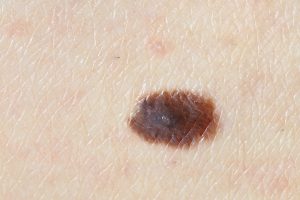 Your skin is your body’s largest organ and serves as the barrier that protects your body from bacteria and other harmful contaminants. Like any other organ in your body, your skin can develop cancer. According to the Skin Cancer Foundation, 1 in 5 Americans will be affected by skin cancer at some point in their lives.
Your skin is your body’s largest organ and serves as the barrier that protects your body from bacteria and other harmful contaminants. Like any other organ in your body, your skin can develop cancer. According to the Skin Cancer Foundation, 1 in 5 Americans will be affected by skin cancer at some point in their lives.
One of the best ways to protect yourself from skin cancer is to wear broad spectrum SPF every single day, even when it’s cloudy and overcast. It is also recommended that you wear sun protective clothing and hats as often as possible when you are outdoors.
Another strong defense against skin cancer is to be aware of any changes in your skin and have regular check-ups with your dermatologist. If you find a suspicious patch of skin or an abnormal freckle or mole, schedule an appointment immediately.
Skin cancer is not necessarily identifiable with the naked eye. The area of skin in question will need to be thoroughly evaluated and tested by a dermatologist. However, there are clues you can look for when you routinely examine the health and condition of your skin:
Actinic keratosis is a red rough patch of skin on sun-exposed areas of the body, like the face. It’s caused by exposure to the UV light in sunlight. Actinic keratosis is the most common form of precancer and can develop into squamous cell carcinoma if left untreated.
Basal cell carcinoma is the most common form of skin cancer and is usually found on the head and neck. It typically appears on skin as a raised, pearly or waxy pink bump. It can also appear translucent with blood vessels near the skin’s surface.
Squamous cell carcinoma is found on the outer layer of the epidermis and appears as red, scaly skin lesions. It shows on areas of sun-exposed skin such as the hands, head, neck, lips, and ears.
Melanoma is probably a term you’ve heard more often than any of the above and that’s because it is the most dangerous form of skin cancer, causing about 73% of all skin-cancer related deaths. It occurs on skin cells that create pigment, like a mole. A suspicious mole will display one or more of the following characteristics:
- Asymmetrical shape
- Border irregularities
- Color that isn’t consistent
- Diameter larger than 6 millimeters
- Evolving size or shape
The Dermatology Center of Indiana services Frankfort, Kokomo, Lafayette, West Lafayette and Lebanon along with many other cities throughout Indiana. Join us today in one of our locations where you are always welcome!
Disclaim: This blog provides general information and discussion about medical, cosmetic, mohs, and surgical dermatology. The words and other content provided in this blog, and in any linked materials, are not intended and should not be construed as medical advice. If the reader or any other person has a medical concern, he or she should consult with an appropriately-licensed dermatologist or other health care worker.
